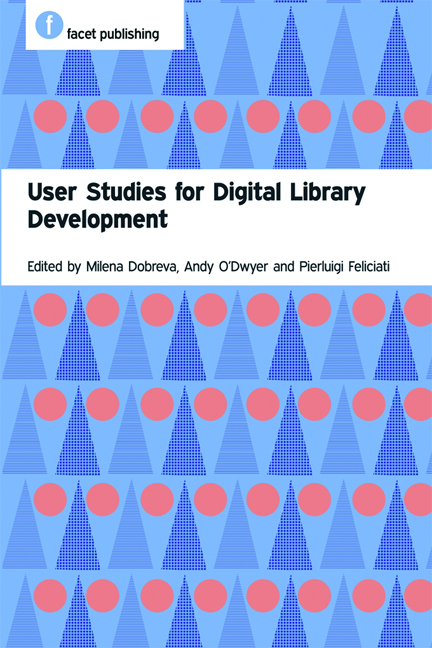Book contents
- Frontmatter
- Contents
- Preface
- Acknowledgements
- Abbreviations
- Glossary
- 1 Introduction: user studies for digital library development
- PART 1 SETTING THE SCENE
- PART 2 METHODS EXPLAINED AND ILLUSTRATED
- PART 3 USER STUDIES IN THE DIGITAL LIBRARY UNIVERSE: WHAT ELSE NEEDS TO BE CONSIDERED?
- PART 4 USER STUDIES ACROSS THE CULTURAL HERITAGE SECTOR
- PART 5 PUTTING IT ALL TOGETHER
- Index
1 - Introduction: user studies for digital library development
Published online by Cambridge University Press: 08 June 2018
- Frontmatter
- Contents
- Preface
- Acknowledgements
- Abbreviations
- Glossary
- 1 Introduction: user studies for digital library development
- PART 1 SETTING THE SCENE
- PART 2 METHODS EXPLAINED AND ILLUSTRATED
- PART 3 USER STUDIES IN THE DIGITAL LIBRARY UNIVERSE: WHAT ELSE NEEDS TO BE CONSIDERED?
- PART 4 USER STUDIES ACROSS THE CULTURAL HERITAGE SECTOR
- PART 5 PUTTING IT ALL TOGETHER
- Index
Summary
Why did we put together this book?
We share a passion for understanding users in the digital library (DL) context and believe that user studies is an exciting area. In the last decade we have been involved in a wide range of user studies across the DL domain, exploiting various research methods to investigate fascinating and important topics with multiple focal points. Studying issues as diverse as individual information needs, the learning styles of people with specific disabilities, crosssectoral userdriven priorities on a national scale, and user response to Europeana – the European Commission's showcase DL – we were faced with the challenge of choosing the most appropriate methods for overall study design, data gathering and analysis, and the presentation of our findings.
Is there a gap in user studies?
Although major reference models developed in the DL domain such as the Digital Library Reference Model (DLRM) (Athanasopoulos et al., 2010) and Streams, Structures, Spaces, Scenarios, Societies (5S) (Goncalves et al., 2004) incorporate the concept of users, they explore this only from a certain perspective. In the case of DLRM, users are one of its six ‘domain concepts’, while in the 5S model they are viewed in relation to Scenarios and Societies; but in both cases they are positioned mostly as clusters or as simplified homogeneous groups. More work is needed on how exactly knowledge about different users and types of user can help the process of development of a DL. Adding clarity to our understanding of users within DL models could help to identify gaps in our knowledge and establish a new research agenda for the user studies domain. Do such gaps exist? Surprisingly, yes – if we take as an example the work on digitization across different information sectors. It is quite alarming that:
we are currently witnessing a paradox: major institutions from the cultural heritage sector clearly emphasize the place of user evaluation and feedback in digitizationrelated policies. But in reality, decisions about aspects of digitization that impact [on] users are frequently taken without direct user involvement.
(Dobreva et al., 2011)- Type
- Chapter
- Information
- User Studies for Digital Library Development , pp. 1 - 18Publisher: FacetPrint publication year: 2012

